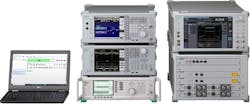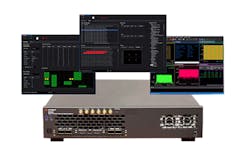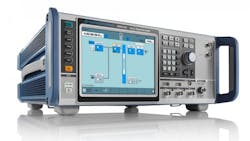5G is rapidly becoming a critical backbone element of the Cloud infrastructure and will also be key to expansion into new application spaces. Proper testing of 5G systems ensures optimum performance under real-world conditions and operation. Here are some related product solutions on the market.
5G RF Regulatory Test System
Anritsu released a RF Regulatory Test System ME7803NR solution for regulatory compliance testing of 5G communications systems. The RF Regulatory Test System ME7803NR uses the Radio Communication Test Station MT8000A as a simulated 5G NR base station in combination with a spectrum analyzer and signal generator to implement ARIB/ETSI/FCC-compliant FR1 RF tests.
In addition, the measurement efficiency and quality of 5G terminals are ensured by the easy-to-operate GUI and built-in calibration function for improved reliability. It is a platform that can perform spurious tests and interference tests, which are difficult for customers to build their own test environment for.
The ME7803NR makes it easy to evaluate whether the RF performance of 5G terminals meets regulatory requirements as well as simplifies evaluation of whether radio-waves are being used efficiently or not, helping 5G market penetration. Anritsu expects its ME7803NR to play an important role in deploying commercial 5G mobile network services by facilitating the spread of 5G terminals.
Verifying Antenna-in-Package Design Performance
The mmWave spectrum is being used to deploy 5G services requiring wider bandwidths to support the high data transfer volume required while also exhibiting low latencies. With the goal of accurately verifying mmWave designs for 5G new radio (NR) and satellite applications, TMYTEK, a Taiwan-based mmWave startup, has selected Keysight's development tools to verify antenna-in-package (AiP) designs used in 5G and satellite systems.
Keysight’s Open RAN Studio validates a radio unit (O-RU), using its software and hardware to construct, play, capture, and measure O-RAN traffic. Open RAN Studio can leverage Keysight’s signal-generation and analysis platforms, PathWave Signal Generation (Signal Studio), and Vector Signal Analysis (89600 VSA) software. This enables TMYTEK to access cross-domain and multichannel O-RAN protocol measurements for both downlink (DL) and uplink (UL).
Keysight’s VXG Microwave Signal Generator offers high output power and ultra-low phase noise, and their UXA Signal Analyzer supports wide analysis bandwidth and dynamic range, critical to both mmWave 5G and satellite applications.
Vector Signal Generator Empowers Midrange 5G, Wi-Fi 6E, and Other Advanced RF Test
At the time of its release, Rohde & Schwarz' SMM100A was presented as the only vector signal generator with mmWave testing capabilities in its class. The instrument meets the rigorous expectations for generating digital signals for the most advanced wireless communication devices entering production, as well as for developing future products and technologies. Manufacturers of state-of-the-art 5G devices wishing to test the whole frequency range possible, expect to do so with a single signal generator for both 5G NR FR1 and FR2 frequencies.
The R&S SMM100A vector signal generator displays RF characteristics across the entire frequency range, from 100 kHz to 44 GHz. It covers all the bands used by any wireless standards, including LTE and 5G NR, as well as the latest WLAN standards Wi-Fi 6 and Wi-Fi 6E (up to 7.125 GHz). Wireless personal area networks such as Bluetooth are covered, too. The instrument’s maximum RF modulation bandwidth of 1 GHz meets requirements to generate the broadband signals used by devices making full use of the most demanding wireless standard specifications, including IEEE 802.15.4z Ultra-Wideband (HRP-UWB).
The R&S SMM100A offers a maximum output power of +18 dBm, which reduces the need for external amplifiers. Excellent modulation frequency response, error vector magnitude (EVM) and adjacent channel power ratio (ACPR) performance result in signal quality for reliable, repeatable test accuracy. The R&S SMM100A comes with six maximum frequency options from 6 GHz to 44 GHz, and four modulation bandwidth options from 120 MHz to 1 GHz to meet all major device band requirements. Users can upgrade their instrument’s capabilities according to their need anytime by simply entering a key code.



